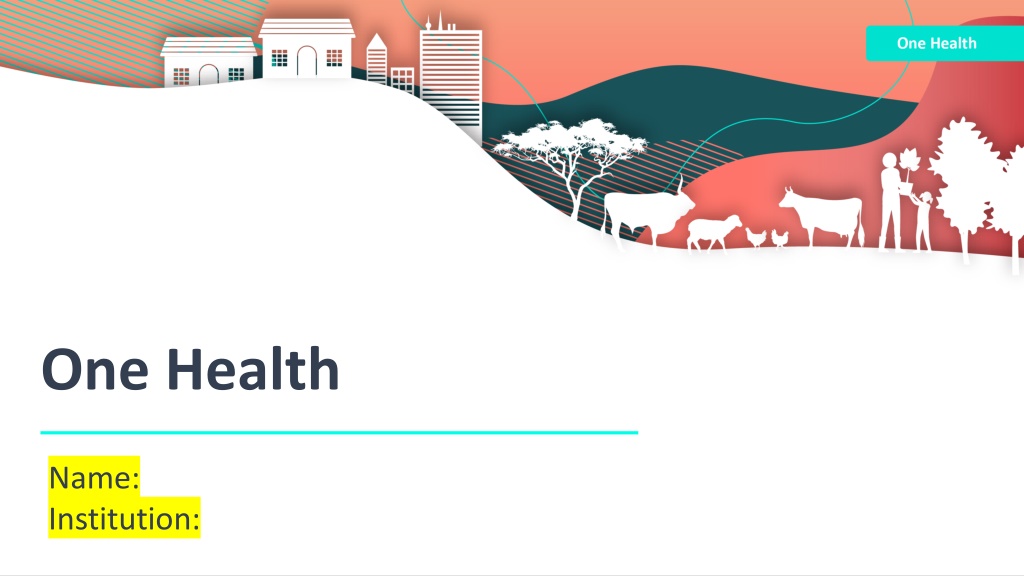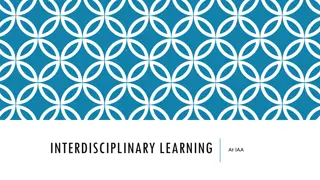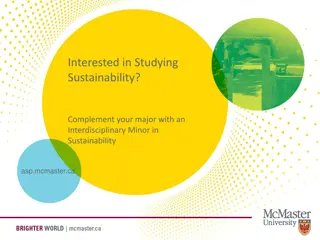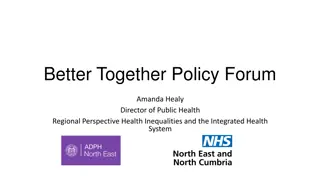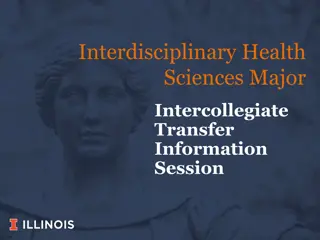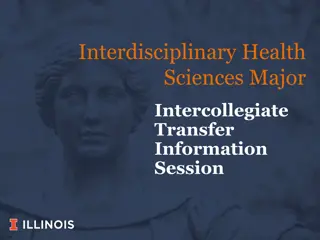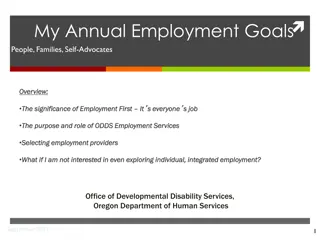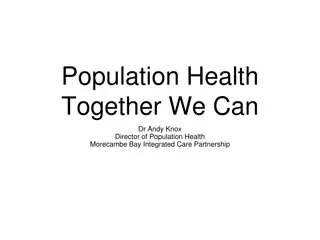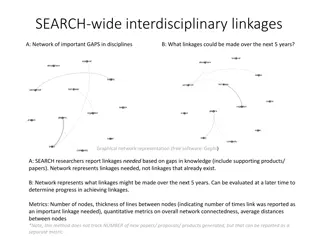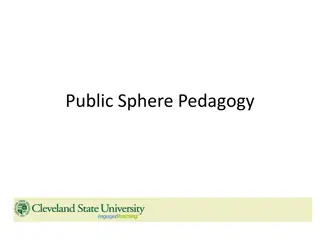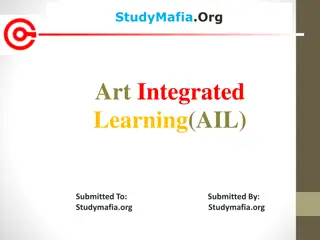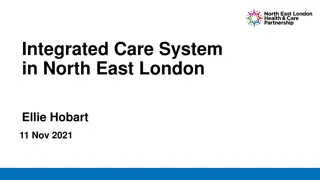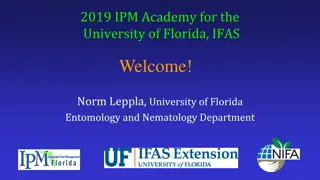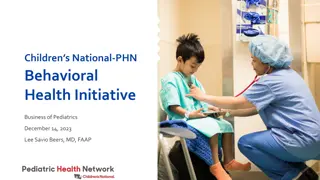Understanding One Health: An Interdisciplinary Approach to Integrated Health
One Health is an integrated approach that emphasizes the interconnectedness of human, animal, and environmental health. This holistic perspective acknowledges the interdependence of these systems and aims to achieve sustainable balance for the well-being of all. By critically engaging with One Health principles, individuals can address current food system challenges and promote integrated health outcomes. The session plan includes activities to explore the history, policy implications, and practical application of the One Health approach.
Download Presentation

Please find below an Image/Link to download the presentation.
The content on the website is provided AS IS for your information and personal use only. It may not be sold, licensed, or shared on other websites without obtaining consent from the author. Download presentation by click this link. If you encounter any issues during the download, it is possible that the publisher has removed the file from their server.
E N D
Presentation Transcript
One Health Name: Institution:
Intended Learning Outcomes Understand One Health's history in science and policy, and its precedent in, and reliance upon, Indigenous knowledge and practices Critically engage with One Health as an interdisciplinary and intersectoral systems thinking approach to achieving integrated health outcomes Recognise the importance applying a One Health approach to identify and tackle current food system challenges Apply systems thinkingto a One Health food system challenge Image Source: ISGlobal (2021).
Session Plan Time Phase 10 min Introduction 10 min Warm-up Activity 10 min Implementing One Health 20 min Breakout Group Activity 1 15 min One Health and Food Systems 20 min Breakout Group Activity 2 5 min Wrap-up 1 hour 30 min
One Introduction Introduction What is One Health?
One Health is an integrated, unifying approach that aims to sustainably balance and optimize the health of people, animals and ecosystems. It recognizes the health of humans, domestic and wild animals, plants, and the wider environment (including ecosystems) are closely linked and inter-dependent. OHHLEP, 2021 Source: OHHLEP (2021), p. 13
Global Health Approach Veterinary Health One Health Prioritises Human Health Prioritises Animal Health Co-Prioritises Human, Animal & Ecosystem Health Example 1 AMR tackled by limiting antimicrobial drug use in hospitals AMR in animals tackled by limiting antimicrobial use in livestock AMR in humans tackled by limiting animal drug use and environmental contamination; accounting for socio-ecological and cultural determinants of overuse. Example 2 Poor mental health among pastoralists attributed to low income Low income attributed to high mortality among livestock Poor mental health attributed to high rates of livestock disease and death, via loss of livelihoods
Scientific Roots of One Health And to focus on anthropogenic changes impacting ecosystem and planetary health To a wider definition to focus on whole society Shifts from narrow, human- centric and biomedical focus Source: Zip Walton
One Health High Level Expert Panel (OHHLEP) Established in 2021 after the quadripartite agreement between the WHO, WAOH, FAO, and UNEP Aim: to give guidance and inputs to enhance cross- sectoral collaboration within the quadripartite agreement to mainstream a One Health approach . Four areas of initial focus: One Health implementation Inventory of current knowledge in preventing emerging zoonoses Surveillance, early detection and rapid data sharing in prevention of emerging zoonoses Factors causing spillover and subsequent spread of diseases. ohhlep--one-health-theory-of- chance.pdf (who.int) One Health High-Level Expert Panel (OHHLEP) (who.int) An essential and primary priority was to develop a common definition of One Health Source: OHHLEP (2021), OHHLEP (2022)
One Healths Precedent in Indigenous Philosophies and Practices (1/2) The Indigenous Peoples of the Kalahari (Southern Africa) "are well- known for the profound connection with their land, intimate knowledge of the natural world, and delicate balance they have maintained for millennia with the environment." In the Andean and Amazonian Indigenous cultures, "Sumak kawsay, or good life in the Kichwa language, is an Indigenous principle promoting living in harmony with nature in order to achieve wellbeing for all." "Indigenous Peoples across Canada are unified in their belief that the wellbeing of an individual is directly connected to the wellbeing of the Land." Hillier et al. (2021) Survival International (2022) Pachamama (2022)
Latest Quadripartites Action Plan Now Recognizes This! Source: FAO, UNEP WHO, and WOAH. (2022).
One Healths Precedent in Indigenous Philosophies and Practice (2/2) Figure 2: Global map of lands managed and/or controlled by Indigenous Peoples (Garnett et al., 2018) Colonial era and contemporary economic regimes threaten Indigenous People's sovereignty and right to self-determination Indigenous Peoples maintain 80% of the globe's biodiversity on 25% of its land (Sobrevila, 2008) (Garnett, 2018) Humans are viewed as stewards or guardians of natural resources, rather than owners (Kuhnlein, 1996) Figure 1. The Andean Ayllu concept of Holistic Well-Being. Runa Ayllu: humans and domesticated plants, animals, water, etc.; Sallka Ayllu:wild plants and animals; Auki Ayllu: the sacred and the ancestors; Ayni: reciprocity. (Swiderska et al., 2022) [OPTION TO INCLUDE AN EXAMPLE OF A LOCAL INDIGENOUS COMMUNITY WORKING TOWARDS INTEGRATED HEALTH IN YOUR REGION OR COUNTRY]
Alternative Integrated Health Paradigms Planetary health Ecohealth Human health is inextricably linked to the health of our planet and natural ecosystems, requiring environmental stewardship to tackle degraded planetary systems for human health. Strives to improve human and animal health through achieving healthier ecosystems. It increasingly adopts One Health and Conservation medicine under its remit. In this model, socio-ecological drivers of health are emphasised. Zinsstag (2013) Steffen et al. (2015) For a comparison of the three holistic approaches to health, see Lerner and Berg (2017)
Two Warm Warm- -Up Activity Up Activity Consider how One Health relates to your work
Warm-up Activity Chat Box Discussion List some of the key challenges across A-N-H that would benefit from a One Health approach? Source: OHHLEP (2022), p. 11
Three Implementing One Health Implementing One Health Key competencies and principles
Paradigm shift: environmental stewardship and recognition of anthropogenic drivers System-thinking: holistic approach to understanding the problem Sociopolitical and multi-cultural parity: gender-responsive and human rights- based approaches Multi-sectoral and inter/trans- disciplinary responses: integrating diverse knowledge forms Underlying principles necessary to implement a One Health approach
Paradigm Shift The paradigm shift within One Health requires people to reconnect with indigenous ways of life and reduce the level of extraction and destruction by recognising that We are part of a complex, adaptive ecosystem Our health is directly dependent on ecosystems' health Our presence is more about belonging than conquering Our role is stewardship rather than ownership Work with the natural evolutionary and ecosystem processes to enhance life on earth, rather than exploit and degrade See the Roadmap to a One Health Agenda 2030 Image Source: Unknown via pxfuel
Systems Thinking: A key principle, but lacking implementation Developing an understanding of the workings of a system to better understand its purpose and predict its behaviour (and if necessary, how that can be influenced for the better). (Stroh, D. 2015, Arnold and Wade, 2015) Source: Hitziger, et al. (2021). An understanding of how complex systems behave, using a holistic approach (holism) that aims to include multiple perspectives (pluralism). (Chapman 2015) Recognising the relationship between a system s structure and its behaviour and outcomes. (Meadows 2009) Image Source: OHHLEP (2022), p. 11
Multi-Sectoral and Inter/Trans-disciplinary Responses Stakeholder mapping Interdisciplinarity Hayes et al. (2021). Humboldt-Dachroedenet al. (2020).
Rights-Based Approaches: Sociopolitical and multi-cultural parity Redvers, et al. (2022) Garnier, et al. (2020)
Four Breakout Group Activity 1 Breakout Group Activity 1 Consider the challenges in implementing One Health in your field
Group Discussion: One Health Implementation Challenges What do you think the main challenges of adopting a One Health approach are? Each group will be assigned approach below. For this approach, consider the potential challenges you may face when trying to adopt the aspects of One Health that we outlined previously.
Group Discussion: Feedback What do you think the main challenges of adopting a One Health approach are? Consider the potential challenges you may face when trying to adopt the aspects of One Health that we outlined previously.
Challenges to One Health Implementation Starting Funding and policymaker commitment Education and training Execution Surveillance: fragmented and capacity Collaboration: multi-actor, multi-domain Monitoring and evaluation Evidence of added value Multi-level collaborations Institutional and academic fragmentation Geographical and cultural fragmentation Source: Dos S. Ribeiro et al., (2019)
Five One Health and Food Systems One Health and Food Systems Detailing the key areas for Food Systems
One Health Relevance to Food Systems OHHLEP Key Areas for Action Highly Pathogen Avian Influenza EMERGING ZOONOTIC EPIDEMICS AND PANDEMICS CAPACITY BUILDING Schistosomiasis, Trypanosomiasis NEGLECTED ZOONOTIC DISEASES Campylobacter FOOD SAFETY HAZARDS ANTIMICROBIAL RESISTANCE Methicillin Resistant Staphylococcus Aureus Climate change, biodiversity loss, and land- use change ENVIRONMENT AND HEALTH Source: OHHLEP. (2021).
Emerging Zoonotic Epidemics and Pandemics One Health and Food Systems
Emerging Zoonotic Epidemics and Pandemics (1/4) Image source: Rural21 (2020)
Emerging Zoonotic Epidemics and Pandemics (2/4) Image source: UNEP & ILRI, (2020), p.15.
Emerging Zoonotic Epidemics and Pandemics: Avian Influenza (3/4) Source: FAO (2021)
Emerging Zoonotic Epidemics and Pandemics: Avian Influenza (4/4)
Emerging Zoonotic Epidemics and Pandemics: Avian Influenza (4/4)
Emerging Zoonotic Epidemics and Pandemics: Avian Influenza (4/4)
Emerging Zoonotic Epidemics and Pandemics: Avian Influenza (4/4)
Emerging Zoonotic Epidemics and Pandemics: Avian Influenza (4/4)
Emerging Zoonotic Epidemics and Pandemics: Avian Influenza (4/4)
Emerging Zoonotic Epidemics and Pandemics: Avian Influenza (4/4)
Emerging Zoonotic Epidemics and Pandemics: Avian Influenza (4/4)
Food Safety Hazards One Health and Food Systems
Food Safety Hazards Agriculture, Nutrition, and Health (1/2) Food safety is an integral part of food security. Food security exists when all people, at all times, have physical and economic access to sufficient, safe and nutritious food that meets their dietary needs and food preferences for an active and healthy life. Hazards familiar to ANH researchers: Biological: Foodborne pathogens (including zoonotic e.g., Salmonella, E. coli, Campylobacter, brucella, etc., and antimicrobial resistant strains) Chemical: Mycotoxins, residues of pesticides or drugs, processing chemicals (addition/contamination) etc. Physical: Extraneous/foreign materials e.g., glass, plastic, metal etc. FAO (1996) Food safety hazards definition: Food safety hazards definition: biological, chemical, or physical agents in food, including allergens, or a condition of food with the potential to cause an adverse health effect. Hazards may be introduced at various stages from farm to fork, and risks vary between simple and industrialised food systems.
Food Safety Hazards One Health Lens on Campylobacter (2/2) Why Campylobacter spp.? Environment Climate change sensitive, heat stress increases shedding in birds, higher temperatures and humidity increase pathogen survival and replication rates, and vector prevalence, increased human transmission from leisure activities, risk of breaks in cold chain Most important foodborne zoonotic pathogen associated with poultry meat consumption What is it s OH significance? Poultry Humans Common intestinal bacteria, potential to cause diarrhoea, low impact on production, highly transmissible, flies as vectors between flocks, high risk of contamination in processing, AMR strains Acute gastro-intestinal disease, potential fatalities in young & elderly, contributes to environmental enteric dysfunction and stunting, neurological complications (Guillain-Barr Syndrome), cooking kills pathogen, risk contamination of uncooked foods in kitchen preparation. Where should interventions be implemented? Who should be responsible for them? Who bears the cost? Source: Zhang, Beyi & Yin. (2023).
Antimicrobial Resistance One Health and Food Systems
Antimicrobial Resistance - AMR (1/4) AMR occurs when any microorganism (fungi, bacteria, virus, parasite) develops resistance to know anti-microbial (anti-biotics, anti- fungal, antimalarials) treatments. AMR is proportional to the amount of antimicrobial used per person or livestock animal. Unregulated or excessive use in humans and livestock, aquaculture, and agriculture accelerates the emergence and transmission of AMR genes by exerting selective pressure on resistant strains. Public Health 5 million deaths in 2019; predicted to increase to 10 million by 2050 AMR infections cause increased spread to community Increased treatment cost and duration: AMR could cost from $300 billion to more than $3.4 trillion annually by 2050 worldwide. Increased morbidity and mortality of infectious disease Source: O'Neill (2016)
AMR In (animal-sourced) Food Systems (2/4) Animal food systems Contributing factor to the availability of cheap animal-sourced foods Used for growth promotion and disease prevention; secondarily used for disease treatment Poor animal welfare conditions increase the need for antimicrobials A lack of access to pathogen- and animal- specific antimicrobials contributes to poor welfare Alternatives to antimicrobials: vaccines, improved biosecurity, animal welfare, and nutrition Total antimicrobial consumption in animals in 228 countries is estimated at 63,151 tons. Projected to rise by 67% by 2030, and nearly 100% in Brazil, Russia, India, China, and South Africa (Van Boeckel, 2010).
AMR In the Environment (3/4) Environment Antimicrobial pollution from pharmaceutical production, agricultural run-off, livestock manure for fertilizer, and human waste Large volumes enter waterways and other ecosystem Exposes a wide range of microorganisms to antimicrobial-resistant genetic material increasing the likelihood of AMR emergence Horizontal gene transfer occurs environmentally Image Source: Walsh (2018)
AMR - Management (4/4) How do we ensure antibiotic access for humans and livestock whilst reducing the drivers of AMR emergence? Managing AMR requires: A One Health approach considers the following: Biosecurity Surveillance Drug research and discovery Drugs tailored to specific pathogens to prevent overuse Improved animal welfare Regulation of pharmaceutical production, waste management, and sales Tackle the core problem: excessive and non- specific use Access for public health, food security, and ecosystem health Decision-making processes Actions across temporal and geographical scales Inter/Trans-disciplinary
Environment and Health One Health and Food Systems
Environment and Health - Climate Change (1/2) Two-fold: climate change changes disease transmission patterns and investments in irrigation for livestock under food systems transformations in low- and lower-middle income countries increase the risk of vector-borne diseases, such as malaria. The global food system is responsible for up to 30% of total green-house gas emissions -IPCC 2019 Source: Sadie J. Ryan et al. 2019
Environment and Health - Biodiversity Loss (2/2) The links between Agriculture and Biodiversity loss How does this relate to disease emergence? 69% biodiversity decline since 1970, primarily driven by land-use change for agricultural production. Increased likelihood of communicable disease at the wildlife-livestock-human interface: abundance of reservoirs host species in human-dominated landscapes relative to biodiverse ecosystems. WWF (2022) Keesing and Ostfeld, (2021) Increased likelihood of non- communicable disease: homogenization of diets, reduced crop yields, increased reliance on fewer crop and animal species for food provisioning Nitrogen-rich nutrient run-off from aquaculture and terrestrial agriculture cause eutrophication and lethal algal blooms contributing to biodiversity loss Keesing and Ostfeld, (2021) NRDC (2021)
Six Breakout Group Activity 2 Breakout Group Activity 2 Applying systems thinking
